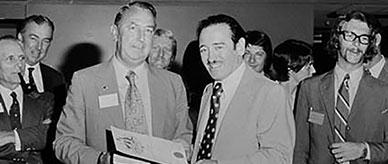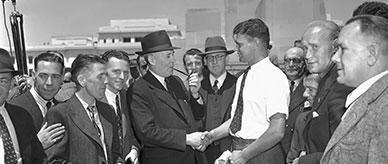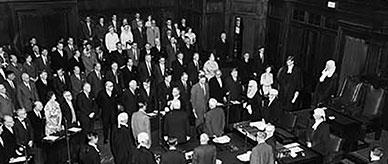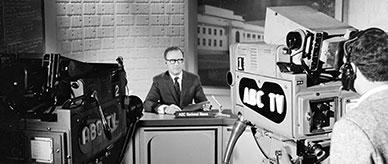
Transcript
Announcer: The Minister for Immigration gives an address on the purpose of the ceremony now.
Arthur Calwell: Your honour, Mr Prime Minister, ladies and gentlemen, we are gathered here today for a ceremony which marks an important milestone in our history. In this hall within a few moments, a Czech, a Dane, a Spaniard, a Frenchman, a Yugoslav, a Norwegian and a Greek will take an oath of allegiance and receive their naturalisation certificates under the new Nationality and Citizenship Act, which became law on Australia Day, a few days ago. It was proclaimed law on that day because it seemed to us the most fitting day for such a declaration of such an important Act. This is the first time such a ceremony has been held, and it is important that on such an occasion we should pause for just a few moments to consider what it is we do. Seven men from seven different countries and with widely different cultural backgrounds intend of their own free choice to become Australian citizens, to assume Australian citizenship. They will adopt that common citizenship which we all hold now by virtue of that Act of Parliament. They have chosen to become fellow citizens with us, and with each other in a country, which they believe and which we believe is notable among the countries of the world for its democratic spirit and for its endeavours to give equal opportunity to all of its citizens, regardless of race or of class or of creed.
It is not of course a new thing for the people of another country to become our fellow citizens. Ever since 1788 when the First Fleet landed the first immigrants on the shores of Port Jackson, this country has needed citizens from overseas. Indeed it would not be too much to say that what the scientists would call the mutations or the jump-forwards in our national evolution have been marked by an influx of new citizens or potential citizens. We have been able to offer them space for new developments, an atmosphere favourable to new ideas, a future free from preconceived notions or rigid hidebound conventions. In turn we have benefited from the originality of their minds, and the energy of all men and women eager to build a future for themselves in new surroundings. After 50 years, Australia ceased to be a collection of six different colonies and became a federal Commonwealth, a new nation. From the beginning of our nationhood, we have made it possible for newcomers from countries outside the British Commonwealth of nations to adopt our common British nationality. Now we propose to share with them our latest acquired status of Australian citizenship in addition to our proud status as British subjects.
We are very glad to see these young men here today, but we have no intention of allowing this ceremony to dwindle into a formal gesture or to swell into an occasion of national bombast. We ask our new citizens to respect the Australian flag and swear allegiance to our concepts of government. We do so not because we want to regiment convenient cannon-fodder for another war, but because we know from long experience that the democratic concepts we cherish are for adaptable and usable means for achieving social change and national progress without dangerous social dislocation or the chaotic spectacle of revolutionary disturbances ending in dictatorial minority rule. We pledge our faith in the commonsense and the national goodwill of the Australian people. We ask our new citizens to swear allegiance to the system of government which enables that good will and common sense to guide democratically elected rulers, and we do not propose to risk the very real gains we have made through democratic evolution for want of vigilance towards our enemies, whether they come from outside or work from inside.
And in conclusion, I wish to introduce the first of our new Australians under the Nationality and Citizenship Act, and I wish them health, wealth and happiness in a country where there is a job of work and a protected future for old and new citizens alike. I have very much pleasure, your honour, in introducing to you the first of our new citizens to take the oath of allegiance. I ask Mr Jan [Jandura–]Pucek to step forward and take the oath.
[INAUDIBLE]
Supreme Court Justice William Simpson: Repeat after me the renunciation. I, and then your name.
Jan Jandura-Pucek: I, Jan Jandura-Pucek
Simpson: Swear by almighty God
Pucek: Swear almighty God
Simpson: That I will … I'm sorry. I, and then your name.
Pucek: I, Jan Jandura-Pucek
Simpson: Renounce my Czechoslovakian nationality
Pucek: Renounce my Czechoslovakian nationality
Simpson: And my allegiance to the republic of Czechoslovakia
Pucek: And my allegiance to republic Czechoslovakia
Simpson: Now we take the Bible [inaudible], please. I …
Pucek: I, Jan Jandura-Pucek
Simpson: Swear by almighty God
Pucek: Swear almighty God
Simpson: That I will be faithful
Pucek: I would …
Simpson: I will be faithful
Pucek: I will be faithful
Simpson: And bear true allegiance
Pucek: And bear true allegiance
Simpson: To His Majesty
Pucek: To His Majesty
Simpson: King George VI
Pucek: King George VI
Simpson: His heirs and successors
Pucek: His heirs and successors
Simpson: According to law
Pucek: According to law
Simpson: And that I will faithfully observe
Pucek: I will be faithfully observe
Simpson: The laws of Australia
Pucek: Laws in Australia
Simpson: And fulfil my duties
Pucek: Fulfil my duties
Simpson: As an Australian citizen
Pucek: As an Australian citizen
Simpson: And here, sir, is your certificate of naturalisation.
[APPLAUSE]
About this record
This sound recording is an excerpt from a live broadcast of the first Australian naturalisation ceremony in Canberra. It begins with Advance Australia Fair and an introduction by Minister for Immigration, Arthur Calwell (1896–1973). Australian Capital Territory Supreme Court Justice William Simpson (1894–1966) administers the Oath of Allegiance and outlines the rights and responsibilities of Australian citizenship to former Czech citizen Jan Jandura-Pucek. Later in the ceremony (but not included in this excerpt) six more European men took the oath to become Australian citizens.
Educational value
- The Nationality and Citizenship Act 1948 provided for non-Australian and British citizens to renounce their former citizenship and to swear allegiance to Australia and the crown – this is the first ceremony at which such change of citizenship took place. Under the Act all Australian-born people are citizens of Australia; previously, Australians had been British subjects.
- Arthur Calwell became Australia’s first Minister for Immigration in 1945 and was instrumental in expanding immigration to include people from Eastern and Southern Europe. He travelled overseas in 1947 to encourage and speed up the process and coined the term 'new Australian'. In his speech, Calwell outlines the advantages of life in Australia and the mutual benefit of the migration program to both migrants and resident Australians.
- The ceremony indicates that in 1949 Australian citizens retained their status as British subjects, and those becoming Australian citizens were required to renounce any former allegiances they had to any other country. As British subjects, Australian citizens swore to be faithful and bear allegiance to the head of the Commonwealth (the King or Queen).
- All seven people naturalised in this ceremony are European, indicative of the White Australia policy and perhaps of how Australia wanted to see itself (as a nation of European descent). Under Calwell’s direction, the Labor Government undertook a major migration program. It set a target of 2 per cent annual population growth, half of which was to be the result of migration. The program, popularly referred to as ‘populate or perish’, continued for the next two decades with the majority of migrants drawn from Britain and continental Europe.
- In a speech later in the ceremony Prime Minister Ben Chifley recognised that at the time many immigrants to Australia had recently fled the horrors of war-torn Europe. Chifley emphasised the importance of welcoming and sympathising with the country’s new citizens. The opportunity, freedom and 'inclusivity' offered by Chifley’s address was rarely extended to ‘coloured’ migrants, as the White Australia policy was still in place.
Acknowledgments
Reproduced with the permission of the Australian Broadcasting Corporation – Library Sales.
Learning resource text © Education Services Australia Limited and the National Archives of Australia 2010.
Related themes
Need help with your research?
Learn how to interpret primary sources, use our collection and more.




